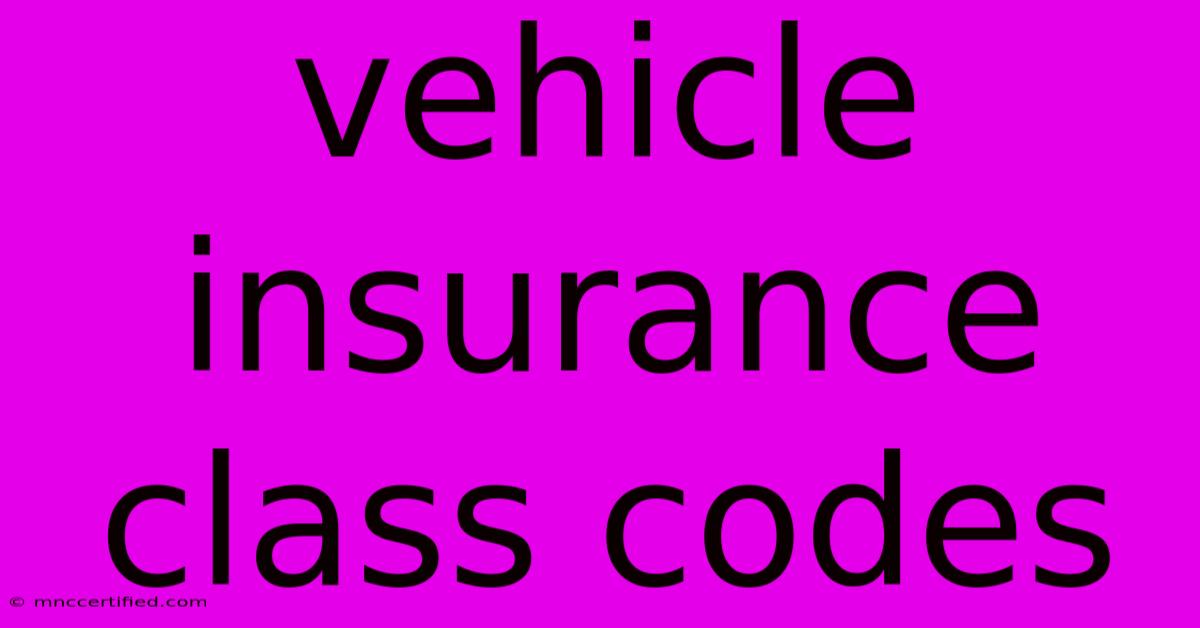Vehicle Insurance Class Codes

Table of Contents
Decoding Vehicle Insurance Class Codes: A Comprehensive Guide
Understanding your vehicle's insurance class code is crucial for securing the best possible car insurance rates. These seemingly obscure numbers significantly impact your premium, often more than factors like your driving record. This comprehensive guide will demystify vehicle insurance class codes, explaining what they are, how they're determined, and how they affect your insurance costs.
What are Vehicle Insurance Class Codes?
Vehicle insurance class codes are alphanumeric designations assigned to vehicles by insurance companies. These codes categorize vehicles based on a multitude of factors, essentially creating a risk profile for each vehicle type. They act as a shorthand, allowing insurers to quickly assess the likelihood of a claim for a specific vehicle. Think of it as a secret code that dictates your insurance premium. Higher risk vehicles, statistically more prone to accidents or theft, will generally fall into higher class codes, leading to higher premiums.
Factors Determining Vehicle Class Codes
Several key factors contribute to the determination of a vehicle's insurance class code. These include:
- Vehicle Make and Model: Certain makes and models are statistically associated with higher accident rates or higher repair costs. Luxury vehicles and sports cars, for example, often fall into higher class codes due to their higher repair costs and potential for more severe accidents.
- Vehicle Age: Older vehicles may have higher class codes due to increased risk of mechanical failure and higher likelihood of theft.
- Vehicle Features: Safety features like anti-lock brakes (ABS), airbags, and electronic stability control (ESC) can influence class codes. Vehicles with advanced safety features may fall into lower risk categories.
- Vehicle Use: The intended use of the vehicle, whether for personal use, commercial use, or ridesharing, will heavily influence the class code. Commercial use, in particular, often commands higher premiums.
- Engine Size and Power: Higher engine displacement and horsepower can be associated with higher risk driving, leading to a higher class code.
- Repair Costs: The cost of parts and labor for repairs significantly impacts the class code. Vehicles with expensive parts tend to fall into higher classes.
How Class Codes Affect Your Insurance Premiums
The class code directly impacts the base rate of your insurance policy. A higher class code translates to a higher premium, reflecting the increased risk associated with that vehicle type. While other factors like your driving record and location influence your final premium, the vehicle's class code plays a significant role. It's a critical component in the insurance company's risk assessment.
Finding Your Vehicle's Class Code
Unfortunately, there's no universal, publicly accessible database for vehicle insurance class codes. The specific codes used can vary between insurance companies. The best way to find your vehicle's class code is to:
- Contact your insurance provider: Your insurance agent or company's website should be able to provide this information.
- Review your insurance policy: The class code might be listed on your policy documents.
Choosing a Vehicle Wisely: Considering Insurance Costs
Before purchasing a vehicle, it's prudent to consider the potential impact of its insurance class code on your budget. Researching the insurance costs associated with different vehicles can help you make a financially sound decision. Comparing quotes from multiple insurers is essential to secure the best possible rate for your chosen vehicle.
Beyond the Code: Other Factors Affecting Your Premium
While the class code is crucial, remember it's not the only factor influencing your insurance premium. Other important considerations include:
- Driving History: Accidents and traffic violations significantly affect your rates.
- Location: Insurance rates vary geographically due to differing risk profiles in different areas.
- Coverage Options: The level of coverage you choose (liability, collision, comprehensive) directly impacts your premium.
- Discounts: Many insurers offer discounts for safe driving, good student status, and other factors.
By understanding vehicle insurance class codes and the broader factors impacting your premiums, you can make informed decisions about your vehicle purchase and insurance coverage, ultimately saving money and ensuring you have the right protection. Remember to regularly review your policy and shop around for the best rates to keep your car insurance costs under control.

Thank you for visiting our website wich cover about Vehicle Insurance Class Codes. We hope the information provided has been useful to you. Feel free to contact us if you have any questions or need further assistance. See you next time and dont miss to bookmark.
Featured Posts
-
National Dog Show Vito Wins
Nov 29, 2024
-
Fox Everett Medical Insurance
Nov 29, 2024
-
Best Walmart Thanksgiving Deals 2024 10 Picks
Nov 29, 2024
-
Nfl Honors John Madden Thanksgiving 2024
Nov 29, 2024
-
Thanksgiving Day Starbucks Hours
Nov 29, 2024